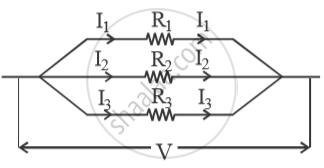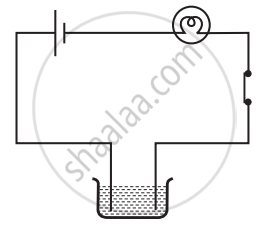Advertisements
Advertisements
प्रश्न
Three resistors of resistances R1 , R2 and R3 are connected (i) in series, and (ii) in parallel. Write expressions for the equivalent resistance of the combination in each case.
उत्तर
(i) Resistance are connected in series :

`therefore` V = V1 + V2 + V3
Same current will pass through all resistors
Using ohm's law ,
`therefore` IRs = IR1 + IR2 + IR3
`therefore` IRs = I (R1 + R2 + R3)
`therefore` Rs = R1 + R2 + R3
where , Rs → Equivalent resistnace in series.
(ii) Resistors connected in parallel :

Potential difference across the resistors will be same
`therefore` I = I1 + I2 +I3
Using Ohm’s law
`therefore V/R_P = V/R_1 + V/R_2 + V/R_3`
`therefore 1/R_P = 1/R_1 + 1/R_2 + 1/R_3` .
APPEARS IN
संबंधित प्रश्न
Two identical resistros of `12 Omega` each are connected to a battery of 3V . Calculate the ratio of the power consumed by the resulting combinations with minimum resistance and maximum resistance.
One unit of coulomb is charge of approximately ______ protons or electrons.
Length: metre scale: : Current: ______
Explain the construction and working of an Telephone.
Water can conduct electricity.
Name the effect of current responsible for the glow of the bulb in an electric circuit.
Boojho made the circuit given in the figure and observed that the bulb did not glow. On Paheli’s suggestion, he added one more cell in the circuit. The bulb now glows. Explain.

Electricity produced on rubbing is ______.
Choose from the options a, b, c and d given in Fig. 12.1 the figure which shows the correct direction of current.
In an electric bulb, light is produced due to the glowing of
